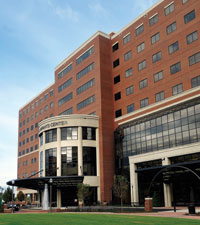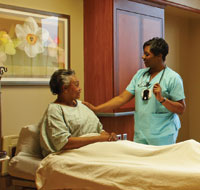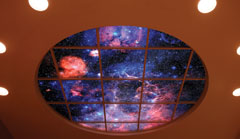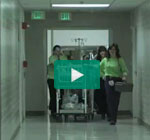Inside UAB's New Women & Infants Center
By Jennifer Park Lollar
 |
The Women & Infants Center combines all inpatient women's services at UAB under one roof for the first time. |
Of all the medical marvels in UAB’s vast new Regional Newborn Intensive Care Unit, the most remarkable may be the doors. To encourage “rooming in”—and the development of the critical bond between parent and child—babies on the unit each have their own rooms, complete with sleep space for adult caregivers plus a sliding glass door and curtains for privacy. The same thing is true in the step-down Continuing Care Nursery on the floor below, making this the largest all-private-room, special-care-nursery unit in the country. In fact, every patient room in the UAB Women & Infants Center is private, and family members are allowed to visit at all hours of the day and night, seven days a week.
The 430,000-square-foot facility, which opened in February, combines all inpatient women's services at UAB under one roof for the first time. It has a direct connection to the rest of UAB Hospital, and bridges will also link up with the new Children’s Hospital now under construction. Caregivers can stay connected to each other anywhere in the hospital by tapping Star Trek-like wireless communicators. They can track patient vital signs remotely and without interruption through the same system.
 |
Caregivers wear wireless communicators to keep in touch with one another throughout the facility. |
“The facility’s design supports the multidisciplinary, family-centered model of care we provide at UAB,” says Wally A. Carlo, M.D., Edwin M. Dixon Professor of Pediatrics and director of the Division of Neonatology. Families can convene in four lounges equipped with kitchenettes, playrooms, and Internet-connected computers. (Wireless Internet access is available in all patient areas of the center.) In the post-anesthesia recovery unit, mothers recuperating from caesarean sections can stay with their well newborns.
The “unique layout” of the Women & Infants Center also allows various specialists to work together with ease, Carlo says. For example, the highest-risk deliveries are performed in the caesarean-section room next to the neonatal intensive care unit (NICU), “which permits seamless transport of infants to the NICU after delivery,” Carlo says. UAB’s survival rate and rate of survival without handicap for all premature babies are already among the best in the country, he notes, and these innovations should improve outcomes even further.
“Babies delivered at UAB are born at the only Alabama hospital with a full-service Level IIIc neonatal ICU—the highest designation possible—and, should problems arise, these babies will have a better chance of surviving than infants born in less well-equipped facilities,” Carlo says.
Debuting alongside the Women & Infants Center is the UAB Comprehensive Cancer Center’s new Hazelrig-Salter Radiation Oncology Center. The 50,000-square-foot building houses the latest radiation therapy equipment (the star-filled ceiling of a treatment room is shown above) in a bright, welcoming space for patients and families. The facility includes dedicated waiting areas for adult and pediatric patients along with spacious private treatment rooms. In front of the facility, the Jim Limbaugh Family Park of Hope Honoring Phyllis Limbaugh offers a green, tree-lined retreat for strolling and relaxing. |
In addition to neonatal care, the 10-story facility “offers a wide spectrum of women’s services, including routine maternity care, routine and complex gynecology, urogynecology, reproductive endocrinology and infertility services, and the only gynecological oncology program affiliated with a National Institutes of Health-designated Comprehensive Cancer Center in Alabama, Louisiana, and Mississippi,” says William Andrews, Ph.D., M.D., chairman of the Department of Obstetrics and Gynecology. “The new Women & Infants Center means our patients are cared for using the latest and most advanced technologies and treatments available in the most technologically advanced building we have to offer.”
It also means more patients can access the world-class care at UAB, notes UAB Hospital CEO Michael R. Waldrum, M.D. “Over the past 10 years, we have experienced a 50 percent increase in demand for women’s and infant’s services,” he says. “The new facility will allow us to fulfill the needs of the community by integrating our advanced clinical services under one roof, in a beautiful building that our patients, their families, and clinical staff will enjoy.”

